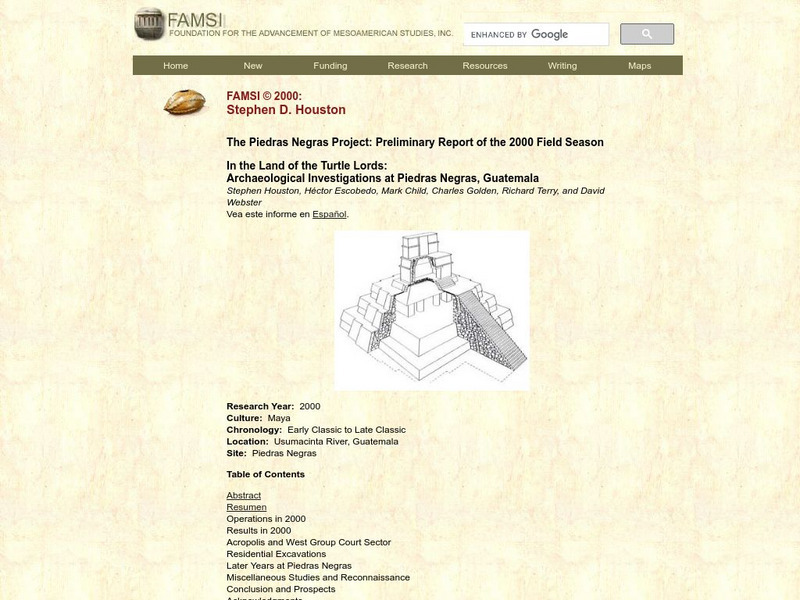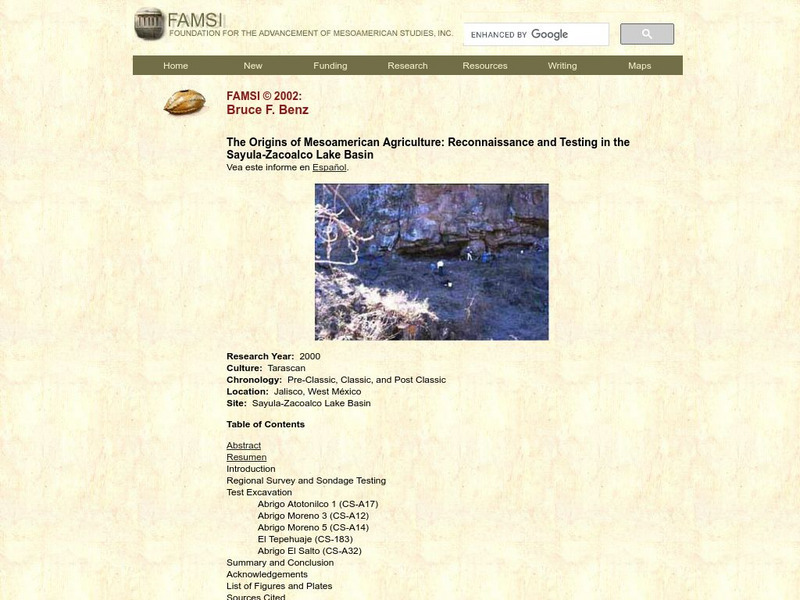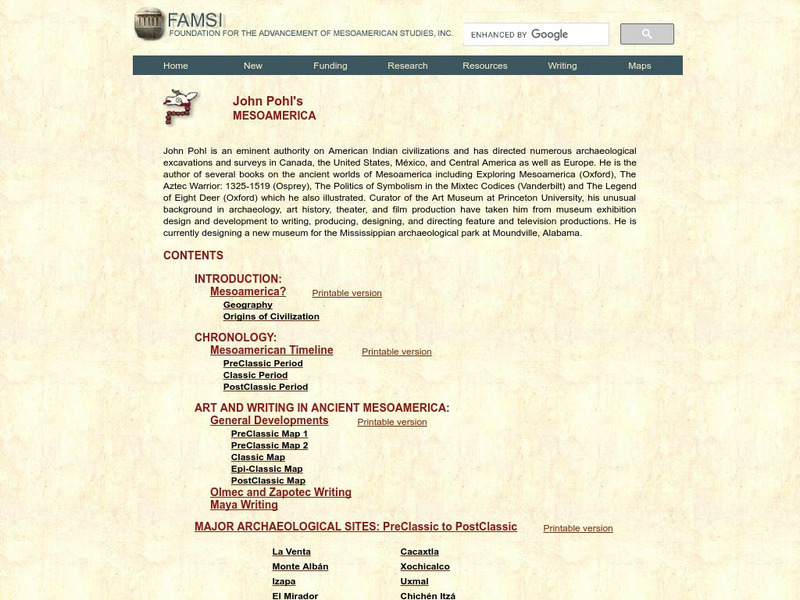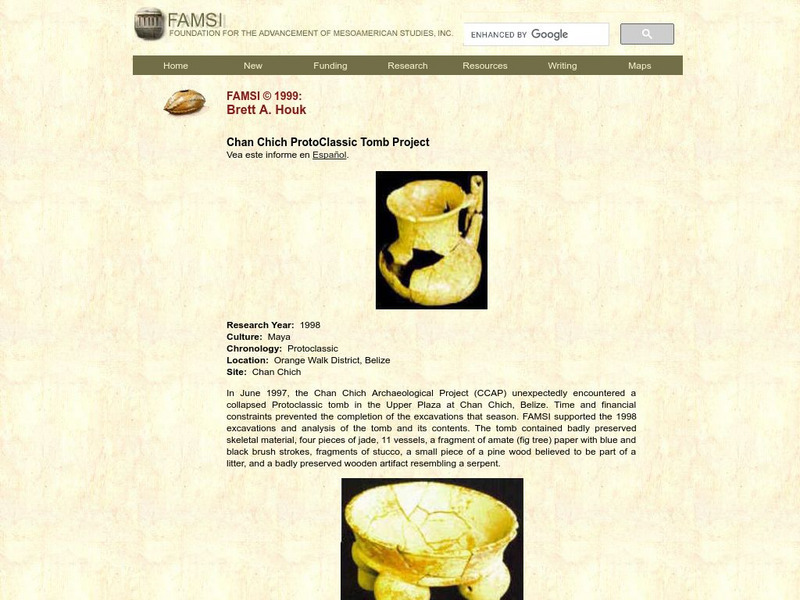Foundation for the Advancement of Mesoamerican Studies
Famsi: Porta Incensario Restoration at Palenque, Chiapas (1998)
Discussion of procedures used to restore six porta incensarios recovered from the Temple of the Cross. Step by step process is revealed and pictures of before and after restoration are included.
Foundation for the Advancement of Mesoamerican Studies
Famsi: Recording New Inscription of Palenque (1995)
Research reports includes an enormous amount of photographs and drawings of stucco hieroglyphs from various temples.
Foundation for the Advancement of Mesoamerican Studies
Famsi: Identifying Individual Hands in (Palenque) Monuments
Study attempts to identify individual artists who created temple hieroglyphs and questions why some monuments indicate more artists at work than others.
Foundation for the Advancement of Mesoamerican Studies
Famsi: The Piedras Negras Project (2000)
Many details of the excavation processes at Piedras Negras allow researchers to write a probable history of the Mayan peoples who lived at this site until the time of its collapse.
Foundation for the Advancement of Mesoamerican Studies
Famsi: Ceramics at Piedras Negras, Guatemala (2001)
Researcher relates phases in ceramic ware to political and social events in the history of Mayan people at Piedras Negras.
Foundation for the Advancement of Mesoamerican Studies
Famsi: The Pomona Kingdom and Its Hinterland (2001)
Pomona Kingdom was contested by Palenque and Piedras Negras and fell under attack several times. A preliminary interpretation of findings allows for a reconstruction of how attacks might have occurred.
Foundation for the Advancement of Mesoamerican Studies
Famsi: Pusilha Archaeological Project (2001)
Report summarizes previous research at Pusilha which indicates that this city had economic, political, and artistic connections with cities of Copan and Quirigua. A history of the city is included.
Foundation for the Advancement of Mesoamerican Studies
Famsi: Olmec Civilization at San Andres, Tabasco, Mx
A significant part of the research is a form of early writing. La Venta's hierarchy is defined by artifacts found during excavations.
Foundation for the Advancement of Mesoamerican Studies
Famsi: Investigation and Conservation at San Bartolo (2002)
Excavation reveals murals in tunnels and earliest example of painted hieroglyphic script in Maya Lowlands.
Foundation for the Advancement of Mesoamerican Studies
Famsi: Radiocarbon Dating of Ritual Features in Oaxaca (2004)
Radiocarbon dating of materials found at Archaic site of Gheo-Shih may be the oldest ritual structure in Oaxaca. Materials also allowed researchers to track movement of Zapotec populations.
Foundation for the Advancement of Mesoamerican Studies
Famsi: El Mapa De Teozacoalco:guide to (Mixtec) Culture (2002)
Using El Mapa de Teozacoalco which was created in 1580 using Mixtec codex paintings, researchers were able to identify and excavate many early Mixtex cities.
Foundation for the Advancement of Mesoamerican Studies
Famsi: Prehispanic Life in Chignahuapan Marsh, Mexico (1999)
Research focuses on Teotihuacan culture at a lake settlement at Chignahuapan Marsh. Excavations of human remains indicate human sacrifice.
Foundation for the Advancement of Mesoamerican Studies
Famsi: Origins of Mesoamerican Agriculture (2000)
Objective of this research was to investigate the cultivation of corn and squash from Archaic period. Human selection transformed teosinte, a weed, into earliest form of maize.
Foundation for the Advancement of Mesoamerican Studies
Famsi: John Pohl's Mesoamerica
Comprehensive overview of Mesoamerica includes an introduction of the term Mesoamerica, the human populations and the region covered, a chronology including the PreClassic, Classic and PostClassic periods, and art and writing in ancient...
Foundation for the Advancement of Mesoamerican Studies
Famsi: Major Archaeological Sites: Tikal
Short history of the Tikal site. Check under the Research link for a Teacher Guide that could be used to study Mayan math and writing. Note that this site can also be viewed in Spanish.
Foundation for the Advancement of Mesoamerican Studies
Famsi: Teotihuacan in the Puuc Region: Foreign Presence?
Very detailed information regarding excavation at Chac II site and archaeological processes. The article articulates findings and makes inferences regarding urban culture. Site may be viewed in Spanish.
Foundation for the Advancement of Mesoamerican Studies
Famsi: Plants of the Underworld: Ritual Plant Use (1998)
Details the use of plants in burial rituals based on findings during excavation at Actun Nak Beh, Barton Creek, Actun Chapat, and Actun Chechem Ha sites in Belize, Guatemala, Honduras, and El Salvador. Site can be viewed in English and...
Foundation for the Advancement of Mesoamerican Studies
Famsi: Investigations of Architecture at Blackman Eddy,belize
Excavation report from Blackman Eddy site in Belize discusses ritual deposits and artifacts. Site can be viewed in English and Spanish.
Foundation for the Advancement of Mesoamerican Studies
Famsi: Early/middle Formative Kanocha Phase at Blackman Eddy
Archaeological investigation at Blackman Eddy in Belize demonstrates architecture related to Olmec style resulting in implications of long distance trade networks. Site can be viewed in English and in Spanish.
Foundation for the Advancement of Mesoamerican Studies
Famsi: Southern Belize Epigraphic Project: Hieroglyphic
Report of a 13 year study of the least documented hieroglyphic of the Mayan culture in Belize and their possible meanings. Site can be viewed in English and Spanish.
Foundation for the Advancement of Mesoamerican Studies
Famsi: Northern Belize Coastal Project, 1999
Archaeological investigations at Saktunja site in Belize focuses on inter-region trade networks and diversification strategies. Site can be viewed in English and Spanish.
Foundation for the Advancement of Mesoamerican Studies
Famsi: Obsidian Craft Production at Cacaxtia Xochitecatl (200)
Archaeological excavation at Xochitecatl indicate that it was an area of production for obsidian goods. Site can be viewed in English and Spanish.
Foundation for the Advancement of Mesoamerican Studies
Famsi: Investigations in Candelaria Caves and La Lima (2003)
Ceramics indicate trade rouses in this well-studied cave. Good insight into ritual practices and materials used in worship.
Foundation for the Advancement of Mesoamerican Studies
Famsi: Chan Chich Proto Classic Tomb Project (1998)
Excavation of tomb indicates the occupant was elite as indicated by wooden snake. Several Mayan artifacts are pictured.

























